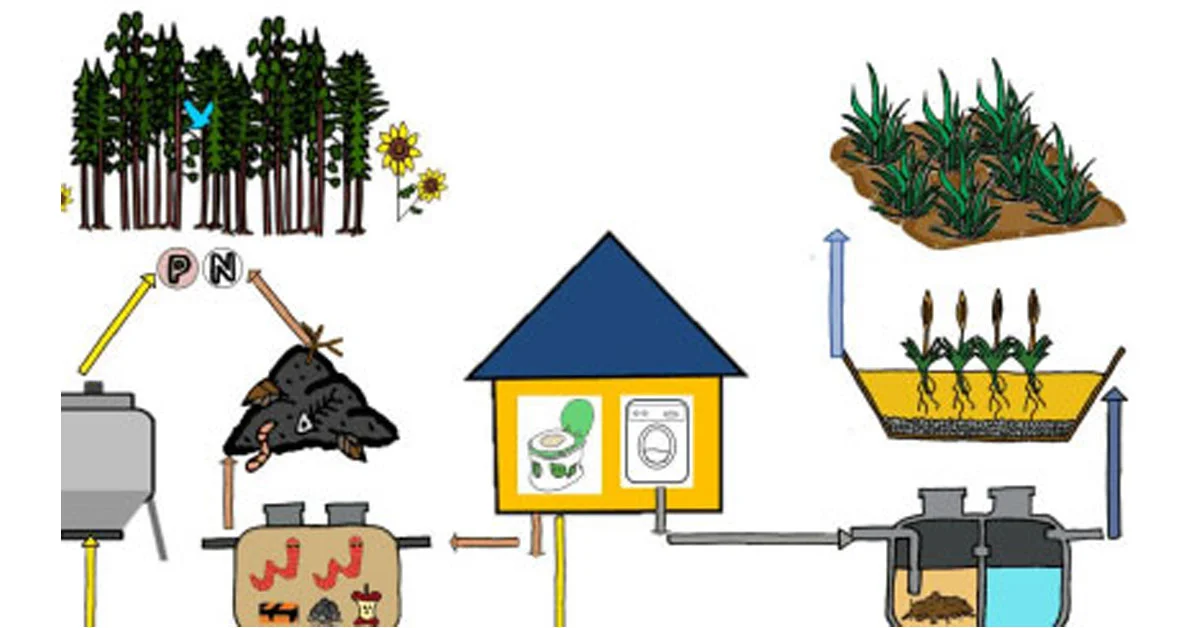Introduction
In a world that is rapidly urbanizing, it’s crucial not to overlook the challenges faced by rural areas when it comes to wastewater treatment. The focus of this blog post is on “Wastewater Treatment,” an issue that demands attention as nearly half of the global population resides in rural regions. This situation is particularly evident in a country like Pakistan, where 62.5% of the population lives in rural areas, yet clean water and sanitation conditions remain elusive for many (Pakistan Bureau of Statistics, 2017).
As we strive to meet the objectives outlined in the United Nations Sustainable Development Goals, particularly Objective 6, which emphasizes equitable and adequate sanitation and hygiene for all by 2030, it’s essential to address the disparities in access to wastewater treatment and sanitation facilities (UN, 2015).
Despite efforts on a global scale to implement wastewater treatment systems, a staggering 80% of wastewater is still discharged into ecosystems without treatment or reuse. Shockingly, 4.5 billion people continue to lack access to safe and clean water supplies as well as proper sanitation facilities, as noted by the World Health Organization (WHO, 2017).
Overview of Sanitation Conditions in Rural Areas
Approximately half of the population of the world lives in rural areas in spite of rapid urbanization over the years. According to the figures, 62.5% of population of Pakistan dwell in rural areas that lack access to clean water and sanitation conditions (Pakistan Bureau of Statistics 2017). According to the objective 6 of the “United Nations Sustainable Development Goals”, access to equitable and adequate sanitation and hygiene conditions for all should be accomplished by 2030.
Regardless of the efforts made to advance the implementation of wastewater treatment systems around the world, about 80% wastewater flows back to ecosystem without reuse or treatment. In addition to this, 4.5 billion people still lack the access to safe and clean water supply and sanitation facilities (WHO 2017). The gap between wastewater generation and treatment capacity is increasing rapidly with time. Figure 1 shows percentages of national population using basic sanitation services (WHO/UNICEF 2017).
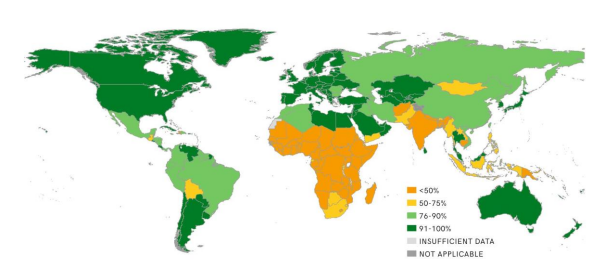
Sanitation data of rural communities indicate significant health, hygiene and socio-economic implications that highlight the alarming need to develop and implement efficient, cost effective, easy to maintain and regional friendly technologies.
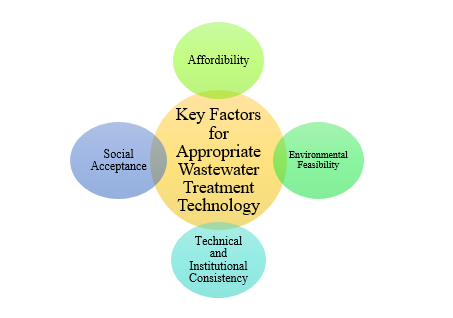
Decentralized Wastewater Treatment Technologies for Rural Setup
A variety of approaches exist for collection, treatment and dispersal or reuse of wastewater in individual dwellings, businesses and entire communities in decentralized wastewater treatment systems. Treatment technologies range from simple passive treatments including soil dispersion to complex biological approaches. Wastewater is usually treated near its generation point. Advantages and limitations of primary wastewater treatments systems is given in table 1.
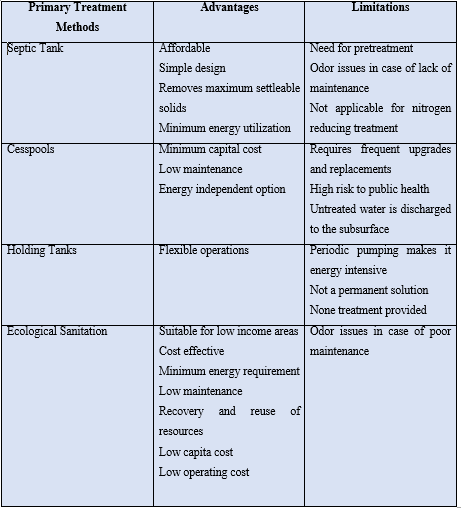
Limitations and advantages of secondary treatment system based on literature review are given in Table 2.
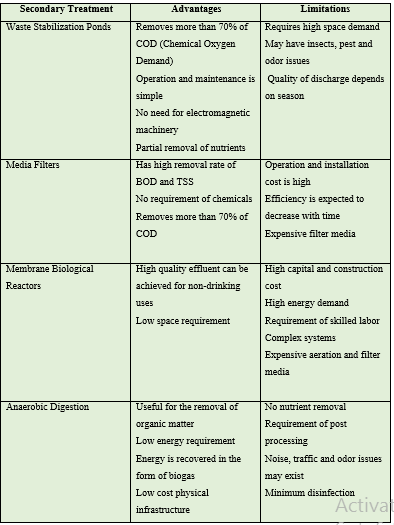
Integrated Decentralized Wastewater Treatment
An integrated decentralized wastewater management system should be based on
- Concept of ecological sanitation
- Separation of grey, brown and yellow water through source control schemes
- Incorporation of traditional as well as alternative systems in a multi-step process
This system is aimed to extract nutrients from brown and yellow water and reuse greywater for non-potable purposes. This design includes combination of septic tanks and constructed wetlands for the treatment of greywater. The resulting effluent is applied to the fields for irrigation and agricultural use. In addition to this, low flush TPS toilets with urine diversion convert brown water into highly fertile black soil. Whereas sanitized urine is used as a soil enhancer.
While subsurface drip infiltration disposes the remaining effluent. The recommended system has a great potential for energy saving. A comparative study performed by Tervahauta et al. (2013) on standardized, centralized and decentralized collection systems showed that centralized systems have the highest primary energy consumers with 914 MJ/yr per person. Whereas decentralized systems with source separation of urine
resulted in reduction in primary energy consumption of up to 522 MJ/yr per person.
With respect to water saving, Friedler et al. (2004) reported that decentralized wastewater treatment systems can save up to 65 – 9 70 l/day per person of potable water. In addition to this, there is also potential for nutrient recycling as well. Krause et al. (2015) showed in their research that TPS compost contains 3.6 times more phosphorus than the normal 31 compost, and faeces from one person can therefore fertilize 900 m2 of land in 32 year.
This recommended design of integrated decentralized wastewater can potentially tighten the closed loop circle of recovery and reuse of resources in wastewater management. Water care always with appropriate relevant and innovative solutions, help communities to treat effluent and sewage with most economical and sustainable tools, and be water positive.
Commemorating World Water Day prompts a collective call to action, urging innovative solutions like integrated wastewater treatment, especially crucial for water-scarce countries, fostering sustainability and resilience in rural communities.
FAQs:
What is Integrated Wastewater Treatment for rural areas, and how does it differ from conventional methods?
Integrated Wastewater Treatment involves combining various treatment processes to efficiently manage and treat wastewater in rural areas. It differs from conventional methods by integrating biological, physical, and chemical processes to achieve higher effectiveness in pollutant removal.
Why is Integrated Wastewater Treatment crucial for addressing water pollution in rural communities?
Integrated Wastewater Treatment is crucial as it offers a comprehensive approach to treat diverse pollutants found in rural wastewater. It ensures that contaminants are effectively removed, preventing water pollution and safeguarding the health of communities and the environment.
Can you explain the key components involved in an Integrated Wastewater Treatment system?
Key components may include screening mechanisms, biological treatment units, filtration systems, and disinfection processes. These work together to remove solids, organic matter, and harmful microorganisms, resulting in treated water suitable for safe discharge or reuse.
How does Integrated Wastewater Treatment contribute to sustainable water management practices in rural settings?
Integrated Wastewater Treatment promotes sustainability by efficiently treating wastewater, reducing environmental impact, conserving water resources, and providing opportunities for water reuse in agricultural or non-potable applications.
Are there cost-effective options for implementing Integrated Wastewater Treatment in resource-limited rural areas?
Yes, there are cost-effective options, including decentralized treatment systems, natural treatment processes, and modular technologies tailored to the specific needs and budget constraints of resource-limited rural areas.
What role does community involvement play in the success of Integrated Wastewater Treatment projects?
Community involvement is crucial for project success. It ensures local acceptance, fosters understanding, and encourages responsible wastewater management practices, leading to the sustainable operation of Integrated Wastewater Treatment systems.
How can Integrated Wastewater Treatment systems adapt to varying wastewater compositions in different rural regions?
Integrated Wastewater Treatment systems can be designed with flexibility to handle varying wastewater compositions. This adaptability may involve modular components and adjustable parameters to accommodate the specific characteristics of each rural region’s wastewater.
What environmental benefits can be expected from the adoption of Integrated Wastewater Treatment in rural communities?
Environmental benefits include reduced water pollution, minimized impact on ecosystems, and protection of groundwater quality. Integrated Wastewater Treatment contributes to overall environmental conservation by ensuring responsible management of wastewater.
Are there any government incentives or support programs for promoting Integrated Wastewater Treatment initiatives in rural areas?
Yes, many governments provide incentives, grants, or support programs to encourage the adoption of Integrated Wastewater Treatment in rural areas. These initiatives aim to address water quality issues and promote sustainable wastewater management.
Can you share examples of successful Integrated Wastewater Treatment projects that have positively impacted rural regions, and what were the outcomes?
Examples include projects implementing decentralized treatment systems, constructed wetlands, and innovative technologies. Positive outcomes often include improved water quality, reduced waterborne diseases, and enhanced environmental sustainability in the treated rural regions.
